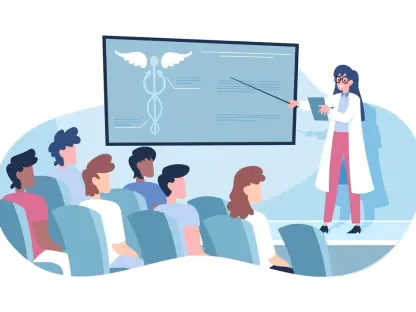What happens when the only hospital in a rural town shuts down, leaving residents stranded miles from emergency care and their medical records in limbo? This stark reality is unfolding across rural America, where hospital closures are not just a local issue but a national emergency. The shuttering of these vital facilities disrupts access to healthcare while exposing sensitive patient data to significant risks. This feature dives deep into the cascading effects of rural hospital closures, exploring the dual threat to patient care and data security.
Why Rural Closures Are Everyone’s Problem
Rural hospitals serve as lifelines for millions, often acting as the sole source of medical care in isolated communities. Yet, nearly 700 of these facilities across the United States face the risk of closure due to financial pressures, staffing shortages, and rising cyber threats like ransomware. When a hospital closes, patients must travel long distances for treatment, leading to delays that can worsen health outcomes. Beyond immediate care, the ripple effects extend to national public health, as entire regions lose critical infrastructure, amplifying disparities in access.
The problem doesn’t stop at care delivery. Closures often mean patient data must be transferred to new systems or providers, a process fraught with security gaps. Without robust safeguards, electronic protected health information (ePHI) becomes vulnerable to breaches during these transitions. This growing crisis highlights a pressing need for systemic solutions to protect both health services and personal information in vulnerable areas.
A Double Blow: Care Gaps and Data Dangers
Consider the fictional case of Angela, a rural resident with chronic lung disease. Her local hospital knew her history inside out, with digital records ensuring seamless care during emergencies. But when that hospital closed due to financial strain, Angela faced a 45-minute drive to the nearest facility. There, missing records meant repeated tests and delayed treatment, putting her health at immediate risk. Such scenarios play out daily as closures force patients into fragmented care systems.
Data security adds another layer of peril. In a real-world example from Illinois, two rural hospitals shut down in recent years after a ransomware attack crippled operations for over 14 weeks. Even when one reopened under new ownership, questions lingered about whether patient data was adequately protected during the transition. Each transfer of ePHI to a new provider or system creates potential entry points for cybercriminals, threatening privacy and trust.
The stakes are high on both fronts. Delayed care can lead to preventable complications or worse, while data breaches expose patients to identity theft and fraud. As closures mount, the intersection of these issues demands attention from policymakers, healthcare leaders, and communities alike to prevent further erosion of rural health systems.
On the Ground: Experts Sound the Alarm
Jackie Mattingly, Senior Director of Consulting Services at Clearwater and a former Chief Information Security Officer for a Kentucky healthcare system, has seen the vulnerabilities firsthand. “Rural hospitals often lack the resources to prioritize cybersecurity, but the cost of neglect can be catastrophic for patient care,” she explains. Her perspective sheds light on a harsh truth: limited budgets and staff leave many facilities exposed to digital threats that can force closures.
Real-world challenges reinforce this warning. In the Illinois case, the ransomware attack not only disrupted services but also strained finances to a breaking point, leading to permanent shutdowns for some. Even when facilities reopen, as one did under new management, ensuring data integrity during ownership changes remains a daunting task. Mattingly’s insights point to a critical gap between the needs of rural hospitals and the resources available to meet them.
These expert voices underscore an urgent reality. Without targeted support and strategic planning, rural communities risk losing not just their hospitals but also the safety net of secure, continuous care. The stories from the field serve as a call for innovative approaches to bolster resilience in the face of mounting pressures.
Strategies to Safeguard Rural Health Systems
Despite the daunting challenges, rural hospitals can adopt practical measures to protect both care delivery and data security. A starting point is conducting a HIPAA-compliant risk analysis to pinpoint where ePHI resides, who accesses it, and what weaknesses exist. This process creates a roadmap for safeguarding patient information while maintaining compliance with federal standards, ensuring that limited resources are directed toward the most pressing threats.
Another key step involves adopting the Health Industry Cybersecurity Practices (HICP) framework, tailored for resource-constrained settings. Implementing basic cyber hygiene—such as endpoint protection, email filtering, and secure remote access—can prevent common attacks that disrupt operations. Additionally, reviewing vendor agreements and mapping data flows during transitions helps minimize exposure when services shift to external partners. These actionable strategies provide a foundation for resilience.
Continuous monitoring and leadership engagement are equally vital. Using managed services for real-time threat detection can bridge gaps in in-house expertise, while involving hospital boards and clinical leaders ensures cybersecurity is treated as a priority tied to patient safety. Developing a phased improvement plan, focused on high-impact actions aligned with available funding, allows steady progress without overwhelming staff or budgets. Together, these steps offer a lifeline to struggling facilities.
Navigating the Fallout of Closures
When a hospital closes, even temporarily for ransomware recovery, the transition of care and data becomes a minefield. Patients are often referred to distant clinics or new providers, with ePHI moving across unfamiliar systems. If not managed carefully, visibility into this data can vanish, creating opportunities for attackers to exploit. The resulting chaos not only disrupts treatment but also erodes trust in healthcare systems among rural populations.
There is, however, a path forward. Hospitals facing potential closure can prioritize security basics, train staff on data handling, and map out clear protocols for transitions. Engaging leadership to champion these efforts ensures accountability at every level. By starting with a comprehensive risk analysis and building a realistic, multi-year strategy, facilities can mitigate risks to both care and compliance, even under intense pressure. Protecting patients during disruptions must remain the ultimate goal.
Looking back, the crisis of rural hospital closures revealed a profound vulnerability in America’s healthcare fabric. Communities grappled with delayed treatments and exposed data as facilities shuttered under financial and cyber strains. The stories of struggle—from fictional patients like Angela to real-world closures in Illinois—painted a sobering picture of loss. Yet, they also sparked a resolve to act. Moving forward, stakeholders must invest in scalable solutions, blending policy reform with on-the-ground tactics to fortify rural hospitals. Only through sustained collaboration can the dual threats to care and data security be addressed, ensuring no community is left behind.









